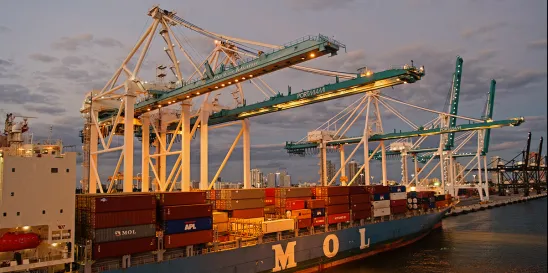In a recent report, the Environmental Protection Agency (EPA) Office of Inspector General (OIG) describes steps the EPA should take to increase air monitoring at marine ports and neighboring communities. While not agreeing to adopt all of the OIG’s recommendations, EPA has agreed to assess the air-monitoring network around ports and in near-port communities and to create a plan to enhance the monitoring network to address any gaps that might be identified.
The OIG report follows an unprecedented increase in cargo handled by U.S. ports, which has resulted in a decrease in air quality at several ports. The primary sources of emissions from port operations include ocean-going vessels (OGVs), cargo-handling equipment, and trucks. The OIG initiated an evaluation in 2022 to determine what steps, if any, EPA was taking to address the increase in air pollution.
EPA is authorized by the Clean Air Act (CAA) to regulate emissions from mobile sources, such as OGVs and trucks. The CAA also requires EPA to establish, update, and oversee attainment of National Ambient Air Quality Standards (NAAQS) for certain air pollutants, some of which are commonly present in ambient air at marine ports and in surrounding communities. To reduce emissions from ports, EPA to date has largely relied on voluntary programs to encourage shipping companies, port authorities, and community organizations to adopt cleaner practices. Since 2008, EPA’s Diesel Emissions Reduction Act (DERA) grant program has been the primary means of replacing and retrofitting older, dirtier diesel engines such as those found in various port equipment and associated vehicles. Going forward, EPA also will be distributing $3 billion from the Inflation Reduction Act (IRA) in grant funding to address air quality at ports.
While tools are in place to improve air quality at ports and in neighboring communities, OIG has identified a need for EPA to enhance its air quality monitoring. Among other things, OIG has recommended that EPA develop guidance for using “citizen science” (monitoring data generated by community groups). In addition, OIG has recommended that EPA set quantifiable performance measures for its Ports Initiative, including a plan for establishing emissions baselines. OIG’s push for increased air monitoring and performance measures is time-sensitive as EPA prepares to award IRA funding for planning, procurement, and installation of zero-emissions technology at ports. A summary of OIG’s findings and recommendations are included in its September 21, 2023 report, The EPA Needs to Address Increasing Air Pollution at Ports.
In response to the OIG report, EPA has identified corrective actions it will take to evaluate its current air-monitoring network, although EPA has noted that monitoring should not be the sole focus of efforts to evaluate emissions and related air quality and has referred to other tools such as emissions inventories and air quality modeling. OIG has accepted EPA’s response with respect to OIG’s recommendations concerning monitoring, but not with respect to OIG’s recommendations concerning the establishment of performance standards. EPA will continue to work on resolving these issues.
With the coming influx of new IRA grant funding designed to reduce OGV, vehicle, and other marine port emissions and to improve air quality, ports can anticipate heightened focus on their vehicle operations and other emission sources.




 />i
/>i

